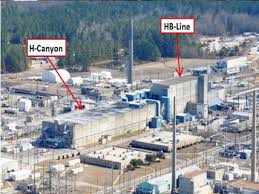
An often-ignored but important agency – the Defense Nuclear Facilities Safety Board (DNFSB) – which conducts oversight of DOE activities reveals that a leaking radioactive drum “believed” to be uranium waste was “discovered” inside the 68-year-old H-Canyon reprocessing plant.
Read below about the status of the leaking drum and potential radiation from it. After all these years of operating the H-Canyon, how could radioactive contamination just show up in the facility and not be addressed quickly and properly? Where will the waste be disposed of – dumped into an unlined low-level waste trench at SRS? Why were supposed drums of depleted uranium stored in the facility and allowed to develop leaks? Investigations are needed. And, we hope the DNFSB keeps their eyes on this as we likely won’t be hearing anything directly from DOE.
Thank goodness for the window on into DOE activities provided by DNFSB, otherwise DOE would carry out one of their main, unspoken objectives unimpeded: keeping the public in the dark. If DOE were committed to transparency and openness they would have posted this news (and would post key documents on a regular basis – sorry, there is no public DOE on-line library – and make sure the broken Freedom of Information Act response situation is fixed. Wake up, Secretary of Energy Granholm! You’re asleep at the openness wheel.)
Defense Nuclear Facilities Safety Board (DNFSB) weekly report for July 21, 2023:
“H-Canyon: On July 8, a radiological protection inspector (RPI) found suspect yellow material
on the floor in a contamination area on the third floor in section 9 of H-Canyon. The
contamination probed 6,000 dpm/100 cm 2 alpha and 700,000 dpm/100 cm 2 beta-gamma. The
RPI barricaded the area, notified the SOM, and then upgraded the location to a high
contamination area/airborne radioactivity area. H-Canyon personnel believe [???] the yellow powder
was from a leaking depleted uranium drum that they found five months prior. When personnel
originally discovered the leak, they pumped the contents into a new drum and bagged the failed
drum but did not label it as waste. During the issue investigation, it became evident that
personnel did not adequately communicate the need to dispose of the failed drum nor did they
fully understand where, when, or by whom the bagged drum was moved. However, it is evident
that the bagged drum was moved at least once. The generator certification official (GCO) only
became aware of the bagged drum on June 14, when Material Control and Accountability
personnel asked the GCO when it would be dispositioned. On June 22, an FPC requested the
relocation of drums in front of the firewater header (where the suspect material was later found).
However, the operators who moved two empty drums in front of the firewater header said they
had not moved the bagged drum. The bag with the failed drum had holes in it, and RPD found
<200 dpm/100 cm 2 alpha and 40,000 dpm/100cm 2 beta-gamma on the outside of bag.
Operations double bagged the drum and tagged it to contact RPD prior to handling or movement.
As an extent of condition, RPIs inspected all drums on the third level. The bagged drum was in
an area that personnel regularly walk down, including for rounds. However, no operators, first
line managers, RPIs, or the FPC were at the issue investigation.”
DOE photos: 68-year old H-Canyon reprocessing plant, now on a shut-down track for the mid-2030s (if there’s no accident before then)